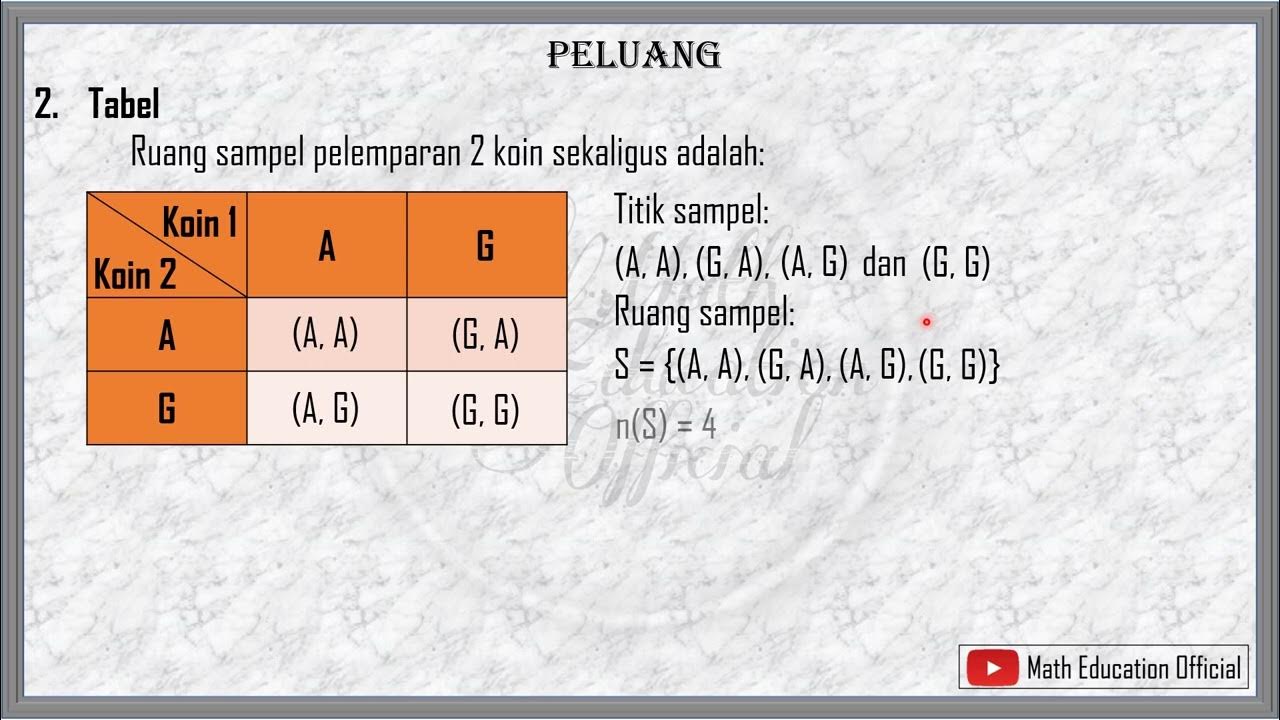Probabilitas 01 Pengenalan Probabilitas Dasar | Belajar Probabilitas
Summary
TLDRThis video tutorial introduces the basics of probability, a fundamental concept in statistics, focusing on key terms like outcomes, sample space, and events. It explains the difference between simple and compound events and uses a dice roll as an example. The video also covers the classical, empirical, and subjective types of probability, illustrating each with examples. It further discusses the Law of Large Numbers and the range of probability values, including complementary events. The tutorial is designed to help viewers grasp the essentials of probability for further statistical learning.
Takeaways
- 😀 The video is an educational introduction to basic probability, aimed at expanding on foundational statistics knowledge.
- 🎓 It's recommended to have a basic understanding of statistics before diving into probability topics.
- 📊 Probability is defined as a measure of the likelihood or chance of occurrence, fundamental to inferential statistics.
- 🔢 Key terms introduced include 'outcome', 'sample space', and 'event', which are essential for understanding probability experiments.
- 📚 The video uses the example of rolling a six-sided die to illustrate the concepts of outcomes and sample space.
- 🎯 Probability experiments are actions or trials that result in a measurable outcome, such as rolling a die or flipping a coin.
- 📈 Tree diagrams (Tridaya G) are introduced as a visual tool to represent each outcome of a probability experiment.
- 🌐 The video explains how to calculate probabilities using classical, empirical, and subjective methods, each with its own use cases and calculations.
- 📝 The classical probability is calculated by dividing the number of favorable outcomes by the total number of possible outcomes in the sample space.
- 📊 Empirical probability is determined by the frequency of occurrence in observed experiments, such as survey responses or observed events.
- 🔄 The Law of Large Numbers is touched upon, stating that as the number of experiments increases, empirical probabilities will approach theoretical probabilities.
- 🔢 Subjective probability relies on intuition and personal judgment, such as a doctor's estimate of surgery success or a student's confidence in passing an exam.
Q & A
What is the main topic of the video?
-The main topic of the video is an introduction to basic probability, which is the first in a series of videos on probability and statistics.
What is the significance of understanding probability?
-Understanding probability is fundamental for moving into inferential statistics, which is also known as inferential statistics.
What is an outcome in the context of probability experiments?
-An outcome is the result of a single trial or experiment in probability.
What is the sample space in probability?
-The sample space is the set of all possible outcomes of a probability experiment.
What is an event in probability?
-An event is a subset of the sample space, which can consist of one or more outcomes.
What is a probability experiment?
-A probability experiment is an action or trial that results in a measurable outcome or response.
How is a tree diagram used in probability?
-A tree diagram is used to visually represent each outcome of a probability experiment, helping to identify each outcome and the sample space.
What is a simple event in probability?
-A simple event is an event that consists of a single outcome.
What is the fundamental counting principle and how is it used in probability?
-The fundamental counting principle is used to calculate the number of possible outcomes from a series of sequential events. It is used by multiplying the number of outcomes for each event.
What are the three types of probability discussed in the video?
-The three types of probability discussed are classical probability, empirical probability, and subjective probability.
How is classical probability calculated?
-Classical probability is calculated by dividing the number of favorable outcomes by the total number of possible outcomes in the sample space.
What is the Law of Large Numbers as it pertains to probability?
-The Law of Large Numbers states that as an experiment is repeated, the empirical probability will approach the theoretical probability of the event.
What is a complementary event in probability?
-A complementary event is the event that includes all outcomes in the sample space that are not part of a given event.
Outlines

Этот раздел доступен только подписчикам платных тарифов. Пожалуйста, перейдите на платный тариф для доступа.
Перейти на платный тарифMindmap

Этот раздел доступен только подписчикам платных тарифов. Пожалуйста, перейдите на платный тариф для доступа.
Перейти на платный тарифKeywords

Этот раздел доступен только подписчикам платных тарифов. Пожалуйста, перейдите на платный тариф для доступа.
Перейти на платный тарифHighlights

Этот раздел доступен только подписчикам платных тарифов. Пожалуйста, перейдите на платный тариф для доступа.
Перейти на платный тарифTranscripts

Этот раздел доступен только подписчикам платных тарифов. Пожалуйста, перейдите на платный тариф для доступа.
Перейти на платный тарифПосмотреть больше похожих видео

STATISTIKA | KONSEP DASAR PROBABILITAS

Peluang [Part 1] - Ruang Sampel dan Titik Sampel

1. RUANG SAMPEL - PELUANG - KELAS 8 SMP

MENENTUKAN RUANG SAMPEL DAN TITIK SAMPEL PELUANG PART 1

Peluang • Part 1: Percobaan, Ruang Sampel, Kejadian, dan Peluang Suatu Kejadian

Mengenal Ruang Sampel, Titik Sampel dan Kejadian
5.0 / 5 (0 votes)
